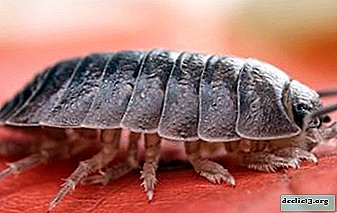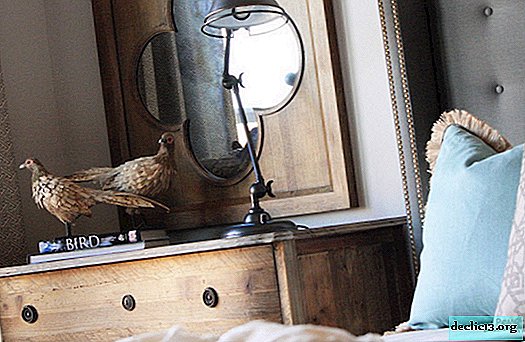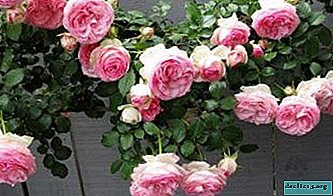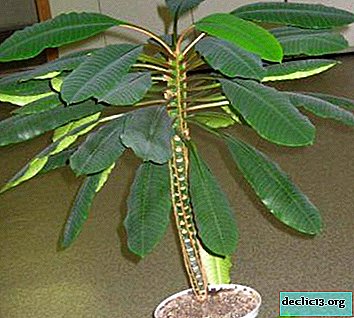A modest decoration of a summer cottage geranium forest: tips for planting and care
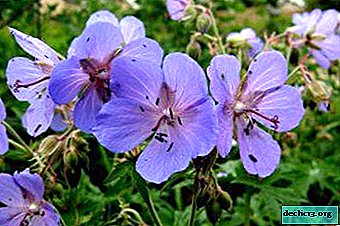
Geranium has long been a classic elegant decoration for a flower bed.
Its beneficial properties are used in traditional medicine and cosmetology.
Neat, compact bushes can decorate the composition of your garden and highlight the desired areas.
Next, consider the popular varieties of how to plant and propagate a street flower. And also, what diseases occur and how to properly treat the plant.
Botanical Description and History
Leaves on petioles palmate or palmate, sometimes feather-shaped, with three to five leaves, some varieties are soft-haired. Peduncles with three flowers.
Flowers of regular shape, medium size, from a five-leafed open calyx and five round petals of the corolla, also opened in one plane; their color is white, purple, blue or lilac. It has up to ten stamens, usually all with anthers.
In Russia, this exotic plant appeared at the beginning of the 18th century, and gained popularity at the beginning of the 19th century. It was bred a century earlier in Europe, from where it migrated to the territory of the Caucasus, where Russian botanists began to study it.
Difference from the meadow crane
Forest geranium (Geranium sylvaticum L. - family Geraniaceae) is a perennial plant that grows mainly in the European part of Russia, the North Caucasus and Siberia. Forest geranium grows in the clearings and fringes with characteristic bushessometimes resembling flower beds. Forest geranium flowers are also noticeable pink-purple, blooms in mid-summer. What is noteworthy, Geranium blooms for a long time - new buds bloom to replace the faded ones.
Meadow geranium, (Geránium praténse L. - family Geraniaceae). Its other name is the meadow crane. This plant belongs to the genus Geranium and the Geranium family. Its stem is strewn with thin hairs. Meadow geranium grows from 30 to 80 centimeters. The tree root goes into the soil 10 centimeters.
The leaves are divided into sections in the form of rhombuses, with veins on the inside. Flowers can take all cold shades, from dark blue to light pink.
On a note. Varieties differ slightly from each other: by the height of the bush, the shape of the leaves and the growing conditions.You can find out more about the description and features of caring for meadow geranium here, and in more detail about the healing properties and contraindications that geranium has, you can find in this material.
Popular varieties of this family of flowers
Album
A bush with a height of 50 cm and a width of approximately 35 cm. The flowers are white, of small diameter (20-30 mm). Bloom twice - in May and in August. This variety is advised to be planted in partial shade, as it is evolutionarily used to these conditions. What can I say, if he suffers the most severe winters with a drop in temperature to -30 degrees below zero!

Amy doncaster
The height of the bush reaches 50 cm, a width of 35 cm. The flowers are blue with a white circle in the center, the diameter of which is approximately 30 mm. Flowering in April, May, August. Like the previous variety, this one is not afraid of the cold.

Mayflower
The height of the bush is about 50 cm, the width is about 35 cm. The color is lilac blue with a white center. Flowering in April, May, repeated in August. Another variety that can be attributed to winter.

Meran
The height of the bush is about 50 cm, the width is about 35 cm. The flowers are purple with a white center, with a diameter of about 30 mm. Flowering in April-May, repeated flowering in August. Location: partial shade. Recommended planting density 9 pcs m2. It transfers temperature drops to -29 ° С.

Photo
In the photo below you can see what the forest geranium looks like.





How to plant?
- Choosing a place to land. It is necessary to choose a sunny, not shaded area, with nutrient fertile soil. As a rule, this is black earth, clay types of soil will not suit us.
- Soil for geranium is selected with a slightly acidic or neutral composition, the content of peat and river sand in the soil will be only a plus. Also, humus and fertilizer will not be superfluous.
- Geranium grows well from seeds. An abundance of varieties is offered in specialized stores. You can find both classic varieties and hybrid ones. Seeds are placed in loose soil in early April. Shoots appear in 10-15 days. At the stage of formation of 3-4 leaves, seedlings dive. Planted in the ground in early June.
Three easy care tips
- Watering. Water should be in moderation, too much provokes a number of diseases. In this case, it’s better to underfill than overflow. It is recommended to water every other day, in small portions of water.
- Lighting. Geranium should be grown in the sun or in partial shade, as it perfectly tolerates frosts. But the complete lack of light tolerates very poorly. If necessary, you can use artificial lighting.
- Pruning. You need to trim the plant as soon as its branches are exposed. It is necessary to cut with a margin, leaving about 5 cm from the soil, so that the crown of the plant grows thick and wide.
Plant diseases: what are they and how to treat them?
Gray rot
Brown spots affect areas of leaves located close to the soil. The plant does not bloom, the leaves dry out and become yellow. Some varieties are stained. With increased humidity, some diseased areas of the flower are covered with gray mushroom plaque.
Attention! The cause of the disease is excessive soil and air humidity, as well as an increased nitrogen content in the soil or as part of fertilizers.This disease is treated with systemic fungicides (Vitaros, Fundazol, etc.). So you can not only protect the plant, but also resume the flowering process.
Alternariosis
The disease makes itself felt in this way: brown spots with a clear focus of lesion appear on the edges of the leaves and petioles, and sometimes throughout the entire area of the leaf plate.
With high humidity, spots become covered with white coating. The plant does not bloom, the leaves dry out and become yellow. We will be cured by proper care, adequate ventilation, and drugs such as Skor or Ridomil Gold.
Rhizoctonia rot
 The lower part of the stem is covered with sunken spots, which can extend up to 25 centimeters. They have a depressed structure and stretch upwards by a maximum of twenty-five centimeters. This process interrupts flowering and starts the process of yellowness and drying of the leaves. The infection is transmitted through the ground.
The lower part of the stem is covered with sunken spots, which can extend up to 25 centimeters. They have a depressed structure and stretch upwards by a maximum of twenty-five centimeters. This process interrupts flowering and starts the process of yellowness and drying of the leaves. The infection is transmitted through the ground.
The disease develops due to an excess of fertilizers, an excessive amount of fertilizers, high air temperature, lack of lighting, high levels of humidity. If the first signs of the disease are detected, you need to stop watering the plant, as this will only exacerbate the problems and process with the following drugs - Vitaros, Fundazol, Rovral.
Late blight
This disease stops the growth of the plant, as a result of which it rots and dies. After the death of the plant on the leaves, you can notice spots, a depressed structure, as well as a mycelial gray coating. Even after the death of the plant, the infection remains in the soil.
Reference. The causes of the disease are, first of all, improper care, high density per meter2, high ambient temperature, insufficient lighting, excess fertilizer and additives.The disease is easier to prevent than to treat, and that means we need to use premium class substrates, to avoid too much humidity. Treatment is carried out with the help of Profit-Gold, Ridomil or Previkur preparations.
Spotting and twisting foliage
First, the plant stops growing, then spots appear on young leaves, which, subsequently, grow and affect the entire plant. The lesion focus is yellow, which is outlined by a silver ring. The edges of the leaves can dry and curl, the nutrition of the leaves is disturbed.
The infection is transmitted from diseased plants through vegetative propagation, as well as through insects (usually a whitefly is a carrier). To prevent the disease, you need to use only healthy plants for reproduction and do not forget about insecticides.
Breeding
The most effective way to propagate geraniums, while maintaining its unique color and shape, is cuttings. With this method, the cuttings inherit all the characteristics, preserving the color and shade of the inflorescences, the shape of the bush and other signs. The best time of the year for this is autumn, since in August you need to trim and get strong, high-quality cuttings.
The probability of success is not always 100%, even if all conditions are met. No need to be upset, just try again.
Agricultural cultivation
 Cut the cuttings, more than 8 cm in length. It is better to cut a little lower than the node.
Cut the cuttings, more than 8 cm in length. It is better to cut a little lower than the node.- Trim the lower leaves, leaving only a couple at the top. If the top leaves are very large, cut them in half. The less resources and substances the leaves of a plant require, the more it allocates to the development of the horse system.
- At this stage, you can immerse the stalk in a solution of root formation stimulants for a couple of minutes.
- In a container with soil, with a pencil, sell a place for escape
- Place the handle in a dark glass dish, add a mixture of water with particles of crushed coal. Sometimes, instead of dishes, they use a plastic bag filled with water, which is tied with an elastic band on the stem to prevent moisture from evaporating.
- When the sprout takes root - you can dig into the soil.
And remember that the plant brings pleasure and delights the eye, you must not forget about proper care, observe all the conditions necessary for growth and not neglect thorough diagnostics in order to avoid neglected diseases, because beauty and elegance more than cover the hours spent on satisfying his whims.

 Cut the cuttings, more than 8 cm in length. It is better to cut a little lower than the node.
Cut the cuttings, more than 8 cm in length. It is better to cut a little lower than the node.


